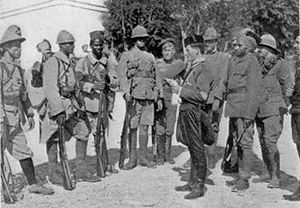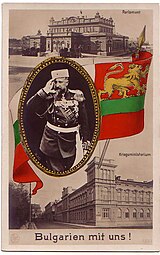The Salonika Front (or Thessaloniki front) of World War I was formed as a result of an attempt by the Allied Powers to aid Serbia, in the autumn of 1915, against the combined attack of Germany, Austria-Hungary and Bulgaria. The expedition came too late and in insufficient force to prevent the fall of Serbia, and was complicated by the internal political crisis in Greece (the "National Schism"). Eventually, a stable front was established, running from the Albanian Adriatic coast to the Struma River, pitting a multinational Allied force against the Bulgarian Army, which was at various times bolstered with smaller units from the remaining Central Powers. The Salonika Front remained quite stable, despite local actions, until the great Allied offensive in September 1918, which resulted in the capitulation of Bulgaria and the liberation of Serbia.
Background[]
Austria-Hungary had attacked Serbia in August 1914 but had failed to overcome Serbian resistance. After the entry of the Ottoman Empire into the war on the side of the Central Powers, the decisive factor was the position of Bulgaria. Bulgaria occupied a strategically important position on the Serbian flank and its intervention on either side would be decisive. Bulgaria and Serbia had fought two wars in the previous thirty years, the Serbo-Bulgarian War of 1885 and the Second Balkan War of 1913. Bulgaria had been defeated in 1913 and there was a widespread feeling in the Bulgarian government and people that Serbia had stolen land which was rightfully Bulgarian. While the Allies could only offer small territorial concessions from Serbia and neutral Greece, the Central Powers' promises were far more enticing, as they offered to give most of the land Bulgaria claimed. With the Allied defeats at the Battle of Gallipoli and the Russian defeat at Gorlice-Tarnów demonstrating the Central Powers' strength, King Ferdinand signed a treaty with Germany and on September 21, 1915 Bulgaria began mobilizing for war.[2]
Triple invasion and the fall of Serbia[]
Conquest of Serbia, 1915

The retreat of the Serbian army at the end of October 1915 from Northern to Southern Serbia.

A propaganda postcard commemorating the victory of the Central Powers over Serbia in 1915.

The retreat of the Serbian troops in the winter 1915/16 across a snowy mountain in Albania to Adriatic coast.

Death in the snow.

Exhausted Serbian soldiers on the seashore in the expectation Allied ships on February 1916.
After the victory of the Serbian army in the Battle of Kolubara in December in 1914 on the Serbian front there was a lull until the early autumn of 1915. Under the command of Field Marshal August von Mackensen, the Austro-Hungarian Balkan Army, the German 11th Army and river flotillas on the Danube and the Sava began an offensive on 6 October 1915, the largest offensive against Serbia. By September 1915, despite the extreme sacrifice of the Serbian army, the Austro-Hungarian Balkan Army, having crossed the rivers Sava and Drina and the German 11th Army after crossing the Danube, occupied Belgrade, Smederevo,Požarevac and Golubac, creating a wide bridgehead south of the Sava and Danube rivers, forcing Serbian forces to withdraw to southern Serbia.[3]
That same day, 15 October in 1915, the two Bulgarian army was suppressed the weak Serbian units, penetrated into the valley of the South Morava river near Vranje up to 22 October 1915, occupied Kumanovo, Štip, Skopje, and prevented the withdrawal of the Serbian army to the Greek border and Thessaloniki.[4] For a year, the Allies (Britain and France) had repeatedly promised to send serious military forces to Serbia, while nothing had been realized. But with Bulgaria's mobilization to its south, the situation for Serbia became desperate. The developments finally forced the French and the British to decide upon sending a small expedition force of two divisions to help Serbia, but even these arrived too late in the Greek port of Salonika to have any impact in the operations. The main reason for the delay was the lack of available Allied forces due to the critical situation in the western front, while the Greek neutrality was used as an excuse, although the Albanian coast was also available for a rapid deployment of reinforcements and supplying of equipment during the past 14 months. As Marshal Putnik had suggested, the Albanian coast was adequately covered by the Montenegrin army to the north—being at safe distance from any Bulgarian advancing direction to the south—in case of a Bulgarian intervention. A second reason for the delay was the protracted secret negotiations with the hope to bring Bulgaria to the Allied camp, in which case no Allied help would be needed.[5]
In any case the lack of Allied support sealed the fate of the Serbian Army. Against Serbia were marshalled the Bulgarian Army, a German Army, and an Austro-Hungarian Army, all under the command of Field Marshal Mackensen. The Germans and Austro-Hungarians began their attack on October 7 with a massive artillery barrage, followed by attacks across the rivers. Then, on the 11th, the Bulgarian Army attacked from two directions, one from the north of Bulgaria towards Niš, the other from the south towards Skopje (see map). The Bulgarian Army rapidly broke through the weaker Serbian forces, that tried to block its advance. With the Bulgarian breakthrough, the Serbian position became hopeless; either their main army in the north would be surrounded and forced to surrender, or it would try to retreat. Many high ranking Serbian officers were killed including Major Jovan Nikolic.[6]
Marshal Putnik ordered a full retreat, south and west through Montenegro and into Albania. The weather was terrible, the roads poor and the army had to help the tens of thousands of civilians who retreated with them. Only c. 125,000 Serbian soldiers reached the Adriatic coast and embarked on Italian transport ships that carried the army to Corfu and other Greek islands before being sent to Thessaloniki. Marshal Putnik had to be carried during the whole retreat and he died just over a year later in a French hospital.
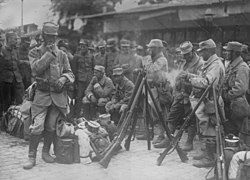
French soldiers halting in Salonica. 1915
The French and British divisions marched north from Thessaloniki in late November under the command of French General Maurice Sarrail. However, the British divisions were ordered by the War Office in London not to cross the Greek frontier. So the French divisions advanced on their own up the Vardar River. This advance was of some limited help to the retreating Serbian Army as the Bulgarian Army had to concentrate larger forces on their southern flank to deal with the threat, which led to the Battle of Krivolak.[7] By mid-December, General Sarrail concluded retreat was necessary in the face of massive Bulgarian assaults on his positions. As with the British, the Germans ordered the Bulgarians not to cross the Greek borders reluctant to risk a Greek entrance to the war against a Bulgarian invasion in Macedonia. The Allies for their part took advantage of that, reinforcing and consolidating their positions behind the borders.[8]
This was a clear, albeit incomplete victory for the Central Powers. As a consequence the railway from Berlin to Constantinople was opened and Germany was able to prop up its weak partner, the Ottoman Empire. A flaw in the victory was that the Allies managed to save a part of the Serbian Army, which although battered, seriously reduced and almost unarmed, escaped total destruction and after reorganizing was able to resume operations six months later. But the most damaging event for the Central Powers was that the Allies—using the moral excuse of saving the Serbian Army—managed to replace the impossible Serbian front with a viable one established in Macedonia (albeit by violating the territory of an officially neutral country); a front which would prove key to their final victory three years later.[9]
Establishment of the Salonika Front[]

Fighting along the Greek border, 1916
The Austro-Hungarian Army attacked Serbia's ally Montenegro. The small army of Montenegro offered strong resistance in the Battle of Mojkovac that greatly helped the withdrawal of the Serbian Army but soon faced impossible odds and was compelled to surrender on January 25.[10] The Austro-Hungarians continued advancing down the Adriatic Coast, attacking into Italian controlled Albania. By the end of the winter, the small Italian Army had been forced out of nearly the whole country.[11] At this point, with the war in the Balkans almost lost, the British General Staff wanted to withdraw all their troops from Greece but the French government protested strongly and the troops remained. The Allied armies entrenched around Thessaloniki, which became a huge fortified camp, earning themselves the mocking nickname "the Gardeners of Salonika".[9] The Serbian Army (now under the command of General Petar Bojović), after rest and refit on Corfu, was transported by the French to the Salonika front.[12]
In the meantime, the political situation in Greece was confused. Officially, Greece was neutral but King Constantine I was pro-German, while Prime Minister Venizelos was pro-British. At first, Greece supported the Franco-British military activity in saving the Serbian army but after the Allies occupied Thessaloniki gradually changed policy.[13] With the Venizelos' resignation, the royalist government settled for officially condemning it but was unable to oppose the superior Allied armies that had landed in Thessaloniki. The Germans, trying to keep Greece neutral, were careful not to cross the Greek border.[14]
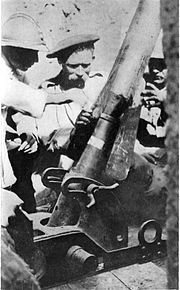
Frenchman instructing Serbian in the use of a trench mortar, 1916-1917.
In May 1916, the French General Sarrail demanded that the Greek Army demobilize. Although the Greek government complied, this action further pushed them to side with the Central Powers. With knowledge that Romania was about to join the Allied side, General Sarrail began preparations for an attack on the Bulgarian Armies facing his forces.[15] The Germans, with excellent intelligence from Greek supporters, made plans of their own for a "spoiling attack". The German offensive was launched on August 17, just three days before the French offensive was scheduled to start. In reality, this was a Bulgarian offensive, as the Austro-Hungarian Army was in Albania and only one German division was on the Greek border. The attack achieved early success thanks to surprise but the Allied forces held a defensive line after two weeks. Having halted the Bulgarian offensive, the Allies staged a counter-attack starting on September 12.[16] The terrain was rough and the Bulgarians were on the defensive but the Allied forces made steady gains. Slow advances by the Allies continued throughout October and on into November, even as the weather turned very cold and snow fell on the hills. The Germans sent two more divisions to help bolster the Bulgarian Army but by November 19 the French and Serbian Army captured Kaymakchalan, the highest peak of Nidže mountain and compelled the Central powers to abandon Bitola to the Entente. Losses in this campaign were c. 50,000 on the Allied side and c. 60,000 killed and captured Bulgarians and Germans, the front had advanced 25 miles (40 km).[17]
The Bulgarian advance into Greek-held Eastern Macedonia precipitated a crisis in Greece. The government, determined to remain neutral, ordered its troops in the area (the demobilized IV Corps) not to resist and to retreat to the port of Kavalla for evacuation but no naval vessels turned up to permit the evacuation to take place. Despite occasional local resistance from a few officers and their nucleus units, most of the troops, along with their commander, were forced to surrender to a token German force and were interned for the remainder of the war at Görlitz, Germany. The surrender of recently hard-won territory to the hated Bulgarians was seen by many Venizelist Army officers as the last straw. With the connivance of the Allied authorities, they launched a coup which secured Thessaloniki and most of Macedonia for Venizelos (see Movement of National Defence). From that point Greece had two governments, the "official" royalist government at Athens, which maintained Greek neutrality in the face of increasing Allied pressure and the "revolutionary" Venizelist government at Thessaloniki. Adding to this confusing situation, the Allies recognized the royalist government until December 1917. At the same time, the Italians had deployed more forces to Albania and these new troops managed to push the Austrian corps back through very hilly country south of Lake Ostrovo.[18]
1917[]
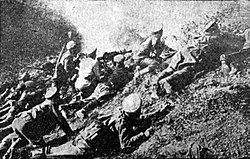
Bulgarian troops counterattack at Yarebichna Peak in 1917
By spring 1917, General Sarrail's Armee d' Orient had been reinforced to 24 divisions, six French, six Serbian, seven British, one Italian, three Greek and two Russian brigades. An offensive was planned for late April but the initial attack failed with major losses and the offensive was called off on May 21.[19] The Allies, wishing to exert more pressure on Athens, occupied Thessaly, which had been evacuated by the royalist Greek Army and the Isthmus of Corinth, dividing the country. After an attempt to occupy Athens by force, that caused the reaction of the local Greek forces and ended in an fiasco in December (see Noemvriana), the Allies established a naval blockade around southern Greece which was still loyal to the king, causing extreme hardship to the people in those areas. Six months later in June, they presented an ultimatum, resulting in the exile of the Greek king (on June 14, his son Alexander became king) and the reunification of the country under Prime Minister Venizelos, supported by Allied bayonets. The new government immediately declared war on the Central Powers and started to create a new Army.[20] Despite this favourable outcome, the new French Prime Minister Georges Clemenceau recalled General Sarrail in November and put a much more diplomatic French General, Adolphe Guillaumat, in his place.[21]
1918[]
Opposing forces in the middle of September[]
Central Powers[]
| Order of battle: Army Group Scholtz (General of the Artillery Friedrich von Scholtz) | ||||||
|---|---|---|---|---|---|---|
| Army | Commander | Note | Corps | Commander | Divisions | |
| 11th German Army | Gen.d.Inf. Kuno von Steuben | LXI. Corps | Lt-Gen. Friedrich Fleck | 1st, 6th & Mixed Bulgarian Division | ||
| LXII. Corps | Lt-Gen. Karl Suren | 302nd German Division, 4th, 2nd & 3rd Bulgarian Division | ||||
| 1st Bulgarian Army | Lt-Gen. Stefan Nerezov | 5th, Mountain, 9th Bulgarian Infantry Divisions & 1/11 Infantry Brigade | ||||
| Order of battle: Bulgarian High Command (Lieutenant General Georgi Todorov) | ||||||
|---|---|---|---|---|---|---|
| Army | Commander | Note | Corps | Commander | Divisions | |
| 2nd Bulgarian Army | Lt-Gen Ivan Lukov | 11th, 7th & 8th Bulgarian Infantry Division | ||||
| 4th Bulgarian Army | Lt-Gen Stefan Toshev | 10th Bulgarian Infantry division & 2nd Bulgarian Cavalry Division | ||||
Entente[]
| Order of battle: Allied Armies of the East (General Louis Franchet d'Espèrey) | ||||||
|---|---|---|---|---|---|---|
| Army | Commander | Note | Corps | Commander | Division | |
| French Army of the Orient | General Paul Henrys | 30th, 76th, 57th, 156th French Infantry Divisions, 35th Italian Infantry Division, 11th French Colonial Division, 3rd & 4th Greek Infantry Divisions | ||||
| Franco-Serbian Group | Voivode Živojin Mišić | Drina, Morava, Yugoslav & Timok Infantry Divisions, 122nd & 17th French Infantry Division | ||||
| 1st Group of Divisions | General Philippe d'Anselm | 16th French Colonial Division, Greek Archipelago Division & 27th British Infantry Division | ||||
| British Salonika Army | General George Milne | XII Corps | Lt-Gen. Henry Wilson | 22nd & 26th British Infantry Division, Greek Serres Division | ||
| XVI Corps | Lt-Gen. Briggs | 28th British Infantry Division & Greek Crete Division | ||||
| II Greek Corps | Xanthi & 14th Greek Infantry Divisions | |||||
| Greek Army | Lt.-Gen. Panagiotis Danglis | I Greek Corps | Lt.-Gen. Leonidas Paraskevopoulos | 1st, 2nd & 13th Greek Infantry Divisions | ||
| 9th Greek Infantry Division (training) | ||||||
Military operations[]

Colonel Nikolaos Christodoulou, one of the leaders of the Greek National Defence army, interrogates Bulgarian POWs
In May, General Guillaumat's Greek troops attacked and captured the strong Bulgarian position of Skra-di-Legen, marking the first major Greek action on the Allied side in the war.[22] With the German spring offensive threatening France, Guillaumat was recalled to Paris and replaced by General Franchet d'Esperey. Although d'Esperey urged an attack on the Bulgarian Army, the French government refused to allow an offensive unless all the countries agreed. General Guillaumat, no longer needed in France, traveled from London to Rome, trying to win approval for an attack. Finally in September, agreement was reached and d'Esperey was allowed to launch his grand offensive.[23]
The Allied forces were now very large, despite the Russians being obliged to cease their participation due to the Treaty of Brest-Litovsk in March 1918. Not only did the Entente have the Greek army fully on their side (9 divisions strong), but they also had some 6,000 men from the Czechoslovak Legion, who had been evacuated from Russia and sailed around the world, ready to fight the Austro-Hungarians. The Bulgarians had also increased their army during 1917 and in total manpower, the two sides were roughly equal (291 Allied battalions vs. 300 Bulgarian battalions, plus ten German battalions). The Allies were certain of their impending victory, while the Bulgarians could see the war was lost. The Ottoman Empire was near collapse, the Austro-Hungarian government was in chaos and the German Army was beaten on the decisive Western Front. The Bulgarians were not willing to fight and die for a lost cause.[24]
The preparatory artillery bombardment of enemy positions for the Battle of Dobro Pole began on September 14. The following day, the French and Serbians attacked and captured their objective.[25] On September 18, the Greeks and the British attacked but were stopped with heavy losses by the Bulgarians in the Battle of Doiran.[26] The Franco-Serbian army continued advancing vigorously and next day, some Bulgarian units started surrendering positions without a fight and the Bulgarian command ordered a retreat.[27]
In the official British government history of the Macedonian campaign, Cyrill Falls wrote a detailed analysis of the situation of the Bulgarian forces and the situation of the front. Although a breakthrough was achieved at Dobro Pole and the allied forces continued their advance, the Bulgarian army was not routed and managed an orderly retreat. By September 29 (a day before Bulgaria exited World War I), Skopje fell but a strong Bulgarian and German force had been ordered to try and retake it the next day; the number of Bulgarian prisoners-of-war in allied hands around that day was only 15,000.[28]
Another major factor contributed to the Bulgarian request for an armistice. A mass of retreating and deserted Bulgarian soldiers had mutinied and converged on the railway centre of Radomir in Bulgaria, just 30 miles (48 km) from the capital city of Sofia. On September 27 leaders of the Bulgarian Agrarian National Union took control of the mutinous troops and proclaimed the overthrow of the monarchy and a Bulgarian republic. About 4,000–5,000 rebellious troops threatened Sofia the next day. Under those chaotic circumstances a Bulgarian delegation arrived in Thessaloniki to ask for an armistice. On September 29, the Bulgarians were granted the Armistice of Thessaloniki by General d'Esperey, ending their war. The Salonika front was brought to an end at noon on 30 September 1918 when the ceasefire came into effect. The Soldiers Uprising was finally put down by October 2. Tsar Ferdinand I of Bulgaria abdicated and went into exile on October 3.[29]
The British Army headed east towards the European side of the Ottoman Empire, while the French and Serbian forces continued north. The British Army neared Constantinople and with no serious Ottoman forces to stop it and the Ottoman government asked for an armistice (the Armistice of Mudros) on October 26; Enver Pasha and his partners had fled several days earlier to Berlin. With "Desperate Frankie" (as the British nicknamed d'Esperey) pushing ever forward, the Serbo-French Army re-captured Serbia and overran several weak German divisions that tried to block its advance near Niš. On November 3, Austria-Hungary was forced to sign an armistice on the Italian Front and the war finally came to an end. On November 10, d'Esperey's army crossed the Danube river and was poised to enter the heartland of Hungary. On request of the French general, Count Károlyi, leading the Hungarian government, came to Belgrade and signed another armistice.[30]
Footnotes[]
- ↑ [1] turkeyswar, Campaigns, Salonika front.
- ↑ Falls 1933, pp. 1–22.
- ↑ Falls 1933, pp. 22–33.
- ↑ Falls 1933, pp. 33–39.
- ↑ Falls 1933, pp. 31–32, 42–50.
- ↑ Falls 1933, pp. 33–37.
- ↑ Falls 1933, pp. 57–62.
- ↑ Falls 1933, pp. 50–84.
- ↑ 9.0 9.1 Falls 1933, pp. 85–103.
- ↑ Falls 1933, pp. 32–36.
- ↑ Falls 1933, p. 110.
- ↑ Falls 1933, pp. 119–120.
- ↑ Falls 1933, pp. 71–81.
- ↑ Falls 1933, pp. 107, 130.
- ↑ Falls 1933, pp. 104–111.
- ↑ Falls 1933, pp. 152–184.
- ↑ Falls 1933, pp. 172–196 234–240.
- ↑ Falls 1933, pp. 208–230, 348–261.
- ↑ Falls 1933, pp. 302–345.
- ↑ Falls 1933, pp. 348–362.
- ↑ Falls 1933, pp. 269–293.
- ↑ Falls 1935, p. 89.
- ↑ Falls 1935, pp. 101–112.
- ↑ Falls 1935, pp. 131–134.
- ↑ Falls 1935, pp. 147–158.
- ↑ Falls 1935, pp. 159–192.
- ↑ Falls 1935, pp. 193–202.
- ↑ Falls 1935, pp. 203–245.
- ↑ Falls 1935, pp. 246–253.
- ↑ Falls 1935, pp. 254–279.
References[]
- Esposito, V. (1959). The West Point Atlas of American Wars, Vol II. Westport, Cn: Praeger. OCLC 311479559.
- Falls, C. (1933). Military Operations Macedonia, From the Outbreak of War to the Spring of 1917 (IWM and Battery Press 1996 ed.). London: HMSO. ISBN 0-89839-242-X.
- Falls, C. (1935). History of the Great War: Military Operations Macedonia, From the Spring of 1917 to the End of the War (IWM and Battery Press 1996 ed.). Nashville, TN: HMSO. ISBN 0-89839-243-8.
- Hall, R. (2010). Balkan Breakthrough: The Battle of Dobro Pole 1918. Bloomington, In: Indiana University Press. ISBN 0-253-35452-8.
- Palmer, A (1965). The Gardeners of Salonika, The Macedonian Campaign 1915–1918. London: Andre Deutsch. ISBN 0-23395-748-0.
- Parker, C. (1964). Return to Salonika. London: Cassell. OCLC 450429.
- Wakefield, A.; Moody, S. (2004). Under the Devil's Eye: Britain's Forgotten Army at Salonika 1915–1918. London: History Press. ISBN 0-7509-3537-5.
External links[]
| Wikimedia Commons has media related to Macedonian front. |
- Balkanalysis.com review of the official British government history of the Salonika Front campaign, Military Operations Macedonia: Parts 1 & 2
- The New Zealand Stationary (Military) Hospital at Salonika (chapter on)
- The New Zealand Stationary Hospital at Salonika (photo of))
The original article can be found at Macedonian front and the edit history here.
